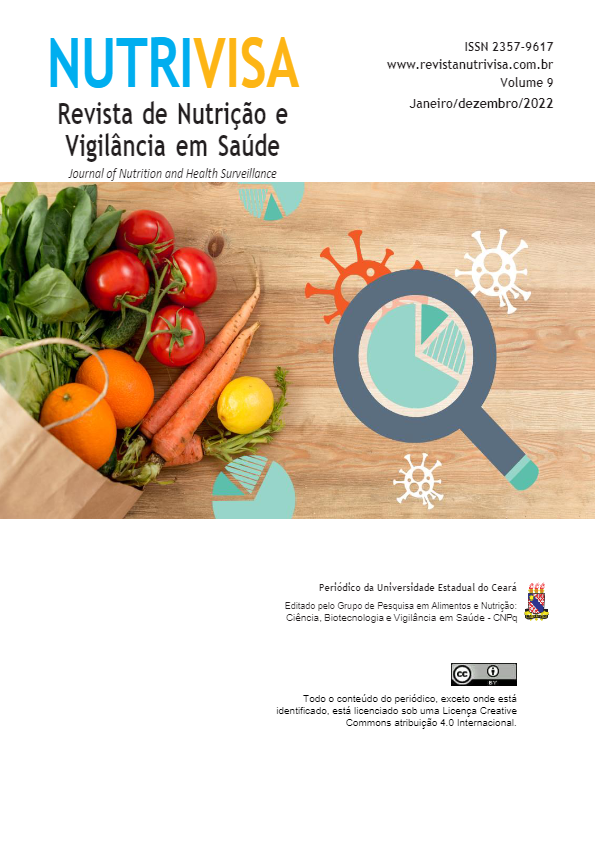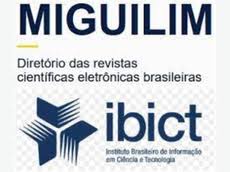Avaliação da informação nutricional complementar para sucos de frutas industrializados em relação aos teores de vitamina C
DOI:
https://doi.org/10.59171/nutrivisa-2022v9e10793Palavras-chave:
sucos de frutas, rotulagem de alimentos, vitamina CResumo
A procura por alimentos práticos e saudáveis aumentou nos últimos anos, assim como a preocupação com a rotulagem nutricional, pois através dela o consumidor se informa sobre as características nutricionais dos alimentos embalados. Entre os produtos prontos para consumo, as bebidas se destacam, como os sucos de frutas industrializados, que são uma alternativa para a ingestão de vitamina C, por sua praticidade. Este estudo objetivou verificar a conformidade da rotulagem de sucos de frutas industrializados diante da resolução de Informação Nutricional Complementar (INC), RDC nº 54/2012. Para tanto, foi avaliada a rotulagem de INC de conteúdo absoluto de vitamina C em oito amostras de sucos de frutas, que continham alegações de “Fonte” e “Rico”, através da análise do teor de vitamina C pelo método de Tillmans. Em seguida, foi feita a comparação com o teor mínimo que exige a legislação de INC. Das oito amostras analisadas, 75% estavam conformes com os teores mínimos de IDR para todos os públicos; 12,5% apresentaram não conformidade com o teor mínimo para o público adulto e 12,5% apresentaram-se não conforme para todos os públicos. Embora a INC seja opcional, pode ser utilizada para atrair o consumidor que busca por alimentos mais saudáveis, sendo determinante na escolha de um produto. Os resultados mostram que há necessidade de inspeção mais rígida pelos órgãos fiscalizadores para proteger os consumidores de produtos que possuem alegações incorretas.
Referências
ARAÚJO, J. P. P.; SILVA, V. V.; Cajucultura: modernas técnicas de produção, Embrapa-CNPAT: Fortaleza, 1995.
BRASIL. Agência Nacional de Vigilância Sanitária. [s.l: s.n.]. Perguntas e Respostas sobre Informação Nutricional Complementar. Disponível em: <http://antigo.anvisa.gov.br/documents/33916/396679/Perguntas_e_Respostas_sobre_Informacao_Nutricional_Complementar.pdf/745a80a9-f27f-43b1-b5e7-b5f4abaae275>.
______. Agência Nacional de Vigilância Sanitária. Instrução Normativa IN n° 75, de 8 de outubro de 2020. Estabelece os requisitos técnicos para declaração da rotulagem nutricional nos alimentos embalados. Diário Oficial da União, Brasília, 9 de outubro de 2020. Disponível em: http://antigo.anvisa.gov.br/documents/10181/3882585/IN+75_2020_.pdf/7d74fe2d-e187-4136-9fa2-36a8dcfc0f8f Acesso em: 31 de jul. de 2023.
_______. Agência Nacional de Vigilância Sanitária. Resolução RDC n° 429, de 8 de outubro de 2020 dispõe sobre a rotulagem nutricional dos alimentos embalados. Diário Oficial da União, Brasília, 9 de outubro de 2020. Disponível em: http://antigo.anvisa.gov.br/documents/10181/3882585/RDC_429_2020_.pdf/9dc15f3a-db4c-4d3f-90d8-ef4b80537380 Acesso em: 31 de jul. de 2023.
______. Agência Nacional de Vigilância Sanitária. Resolução RDC n° 259, de 20 de setembro de 2002. Aprova o regulamento técnico sobre rotulagem de alimentos embalados. Diário Oficial da União, Brasília, de 23 de setembro de 2002. Disponível em: https://lcqa.farmacia.ufg.br/up/912/o/resoluo_rdc_n_259_2002_-_rotulagem_em_geral.pdf Acesso em: 02 de mai. de 2023.
______. Agência Nacional de Vigilância Sanitária. Resolução RDC n° 269, de 22 de setembro de 2005. Aprova o regulamento técnico sobre a ingestão diária recomendada (IDR) de proteína, vitaminas e minerais. Diário Oficial da União, Brasília, de 23 de setembro de 2005. Disponível em: https://coffito.gov.br/nsite/wp-content/uploads/2016/08/resoluo-rdc-n-269-2005-ingesto-diria-recomendada-idr-de-protenas-vitaminas-e-minerais.pdf Acesso em: 02 de mai. de 2023.
CAVADA, G.S.; PAIVA, F.F.; HELBIG, E.; BORGES, L.R. Rotulagem Nutricional: você sabe o que está comendo? Brazilian Journal of Food Technology, v.4, p.84-88, mai. 2012.
CAVALARI, T.; SANCHES, R.A. Os efeitos da Vitamina C. Revista Saúde em Foco, Amparo - SP, 749-765 p. 2018. Disponível em: <http://portal.unisepe.com.br/unifia/wp-content/uploads/sites/10001/2018/09/086_Os_efeitos_da_vitamina_C.pdf>. Acesso em: 13, mai. 2023.
CAVALCANTI, J. J. V. Em O cajueiro: exploração, perspectivas e potencialidades no âmbito da Mata Atlântica; Simões, L. L.; Lino, C. F., Orgs.; Senac: São Paulo, 2002, p. 55.
CORDOVA, A. G. D. Consumo de bebidas vegetais no Brasil: análise da percepção do consumidor, pelo uso de word association. Trabalho de Conclusão de Curso de Graduação (Engenharia de Alimentos). Departamento de Engenharia Química e Engenharia de Alimentos, Universidade Federal de Santa Catarina, Florianópolis, 2019. 49p.
CUNHA, K. D.; SIVA, P.R.; COSTA, A.L.F.S.F; TEODORO, A.J.; KOBLITZLL, M.G.B. Estabilidade de ácido ascórbico em sucos de frutas frescos sob diferentes formas de armazenamento. Brazilian Journal of Food Technology, v. 17, n. 2, p. 139–145, jun. 2014.
DALLAGO, R. M.; TRES, B.P.; DENTI, A.F.; ORO, C.E.D. Avaliação de sucos de laranja artesanais produzidos na Microrregião de Erechim. Revista Perspectiva, v. 44, n. 167, p. 15–24, 16 nov. 2020.
FAO/OMS. Human Vitamin and Mineral Requirements. In: Report 7th Joint FAO/OMS Expert Consultation. Bangkok, Thailand, 2001. xxii + 286p.
FRITZ, H.; FLOR, G.; SEMANAS, L.; COOLEY, K.; CALLACHAN, M.; McGOWAN, J.; SKIDMORE, G.; KIRCHNER, L.; SEELY, D. Intravenous Vitamin C and Cancer: A Systematic Review. Integrative Cancer Therapies, Thousand Oaks, v. 13, n. 4, p. 280-300, may. 2014.
INSTITUTO ADOLFO LUTZ. Normas Analíticas do Instituto Adolfo Lutz. 3. ed. São Paulo: Imprensa Oficial do Estado de São Paulo (IMESP), 1985.
LEE, S. K.; KADER, A. A. Preharvest and postharvest factors influencing vitamin C content of horticultural crops. Postharvest Biology and Technology, v. 20, n. 3, p. 207-220, 2000.
LIMA, E. S.; SILVA, E.G.; NETO, J.M.M.; MOIT, G.C. Redução de vitamina C em suco de caju (Anacardium occidentale L.) industrializado e cajuína. Química Nova, v. 30, n. 5, p. 1143–1146, out. 2007.
LIU, C-S. Vitamin C: Dietary Requirements, Dietary Sources and Adverse Effects. In: KUCHARSKI, Hubert; ZAJAC, Julek (Ed.). Handbook of Vitamin C Research, New York, Nova Science Publishers, p. 127-153, 2009.
MAIA, G. A.; MONTEIRO, J. C. S.; GUIMARÃES, A. C. L.; Ciênc. Tecnol. Aliment. 2001, 21, 43.
MENDES, K. D. F.; GUERRA, A.N.; REIS, A.M.; DOMINGUES, J.; DORIA, S.R.; LOPES, R.G.A. Informação nutricional complementar em bebidas açucaradas consumidas pelo público adolescente e infantil. Vigilância Sanitária em Debate: Sociedade, Ciência & Tecnologia, v. 9, n. 2, p. 68–78, 31 maio 2021.
MIRANDA, L. L. S.; SOARES, C.S.; ALMEIDA, C.A.F.; ALMEIDA, D.K.C.; GREGÓRIA, E.L.; AMARAL, D.A. Análise da rotulagem nutricional de pães de forma com informação nutricional complementar comercializados no município de Belo Horizonte – MG. HU Revista, v. 43, n. 3, p. 211–217, 15 out. 2018.
MORDOR INTELLIGENCE. Relatório de mercado de suco de frutas e vegetais | Tamanho, participação, crescimento e tendências (2023-28). Disponível em: <https://www.mordorintelligence.com/pt/industry-reports/fruit-and-vegetable-juice-market-industry>. Acesso em: 9 maio. 2023.
NAIDU, A. Vitamin C in human health and disease is still a mystery? An overview. Nutrition Journal, London, v. 2, p. 1-10, ago. 2003.
NEW TRADE. Mercado de sucos cresce no Brasil e ganha força nos supermercados. Disponível em: <https://newtrade.com.br/industria/mercado-de-sucos-cresce-no-brasil-e-ganha-forca-nos-supermercados/>. Acesso em: 9 maio. 2023.
NUNES, T. A., MELO, J.K.H; SILVA, G.F; VASCONCELOS, B.M.F.; MOTA, R.L.S. Análise do consumo de fontes de vitamina C entre os estudantes da UFERSA/RN. Exatas Online. v 4. n. 1, 2013.
PAULO, A.A.; KUMAR, S.; KUMAR,V; SHARMA,R. Milk Analog: Plant based alternatives to conventional milk, production, potential and health concerns. Critical Reviews In Food Science And Nutrition, [s.l.], p.1-19, 16 out. 2019. Informa UK Limited. http://dx.doi.org/10.1080/10408398.2019.1674243.
SANTOS, J. T.; KRUTZMANN, M.W; BIERHALS, C.C.; FEKSA, L.R. OS EFEITOS DA SUPLEMENTAÇÃO COM VITAMINA C. Revista Conhecimento Online, v. 1, p. 139, 11 jan. 2019.
SANTOS, M. F. B.; CABRAL, A. C. M. M.; FURQUIM, N. R. Produto alternativo para o mercado brasileiro: sanduíche de hambúrguer de caju e emulsão de castanha de caju congelado. Brazilian Journal of Health Review, v. 3, n. 2, p. 3399–3412, 2020.
STROHECKER, R., HENNING, H.M. Analisis de vitaminas: métodos comprobados. Madrid: Paz Montalvo, 1967. 428p.
ZUCCHI ND, F.G. Analysis of the presence of nutrient claims on labels of ultra-processed foods directed at children and of the perception of kids on such claims. Rev Nutr. 2016;29(6):821-32. https://doi.org/10.1590/1678-98652016000600007
Downloads
Publicado
Como Citar
Edição
Seção
Licença
Copyright (c) 2023 Tereza Raquel Pereira Tavares, Jorgiane da Silva Severino Lima, Lucicléia Barros de Vasconcelos

Este trabalho está licenciado sob uma licença Creative Commons Attribution 4.0 International License.














